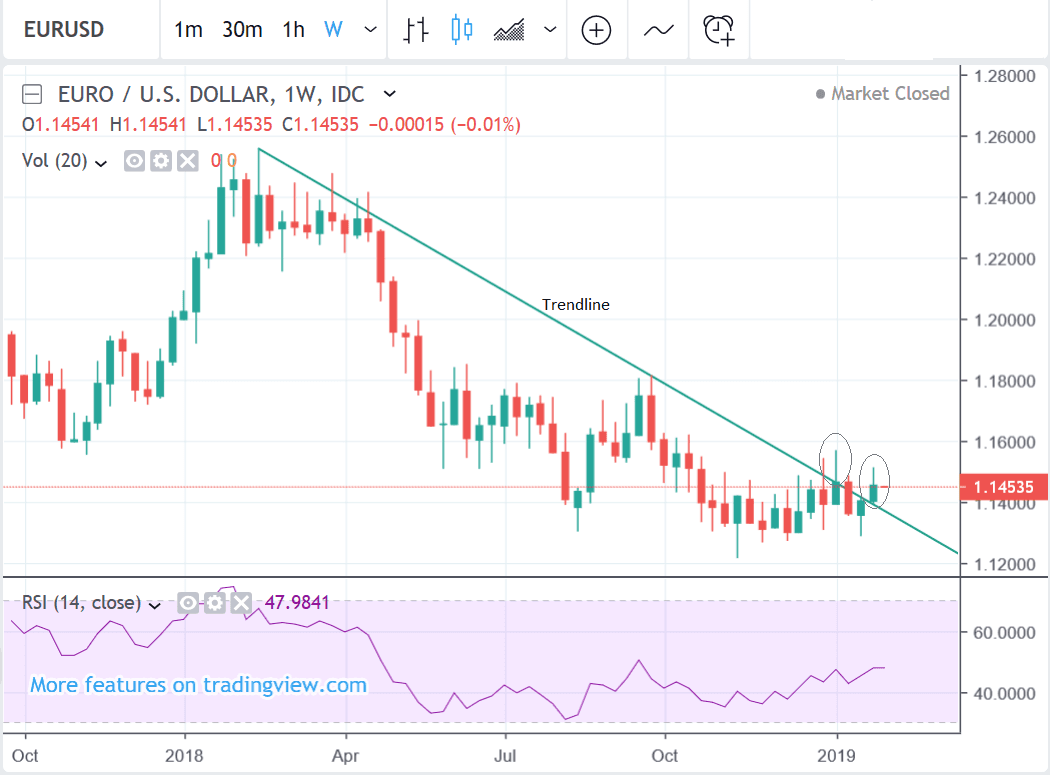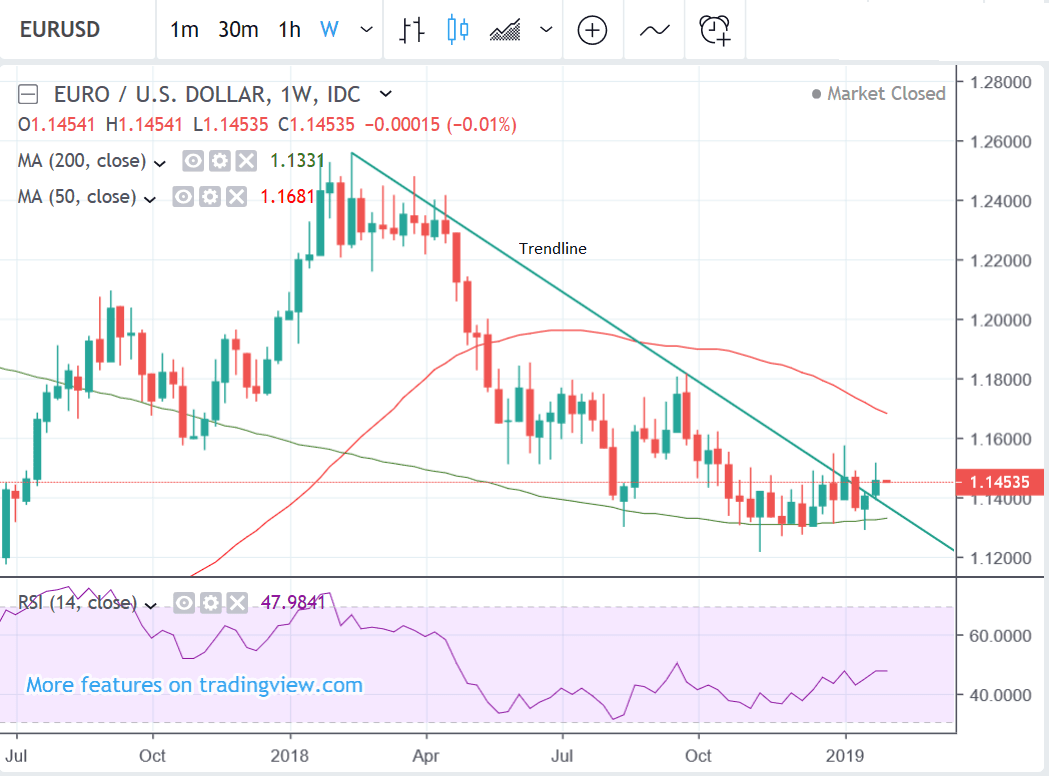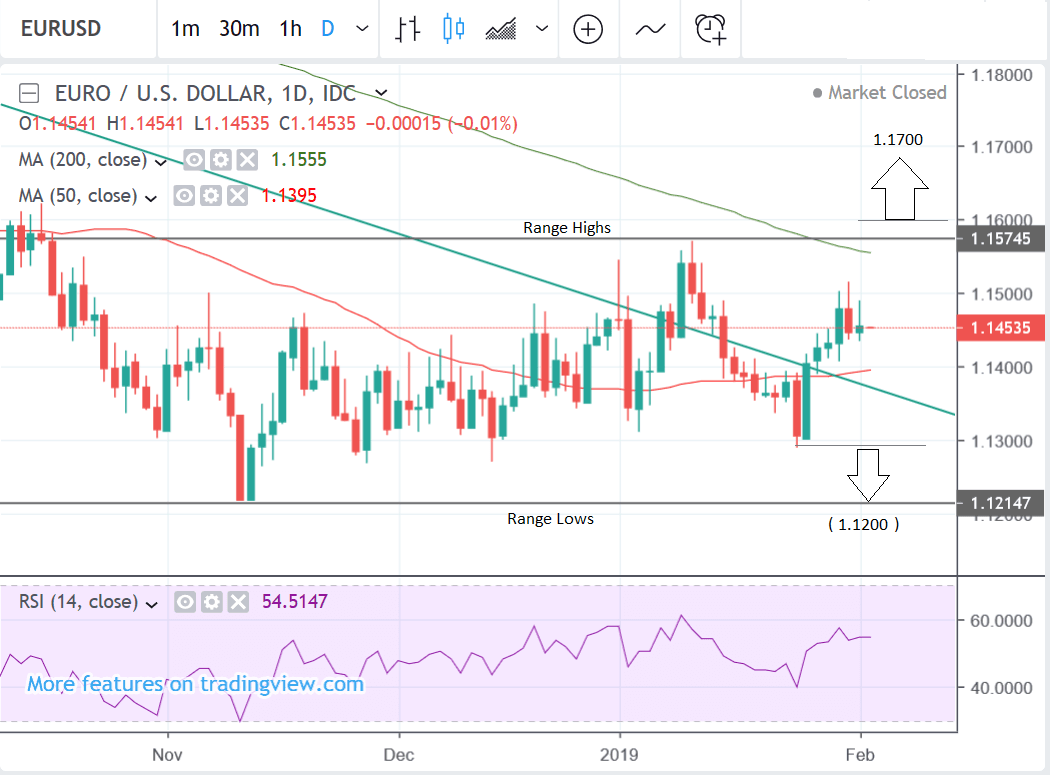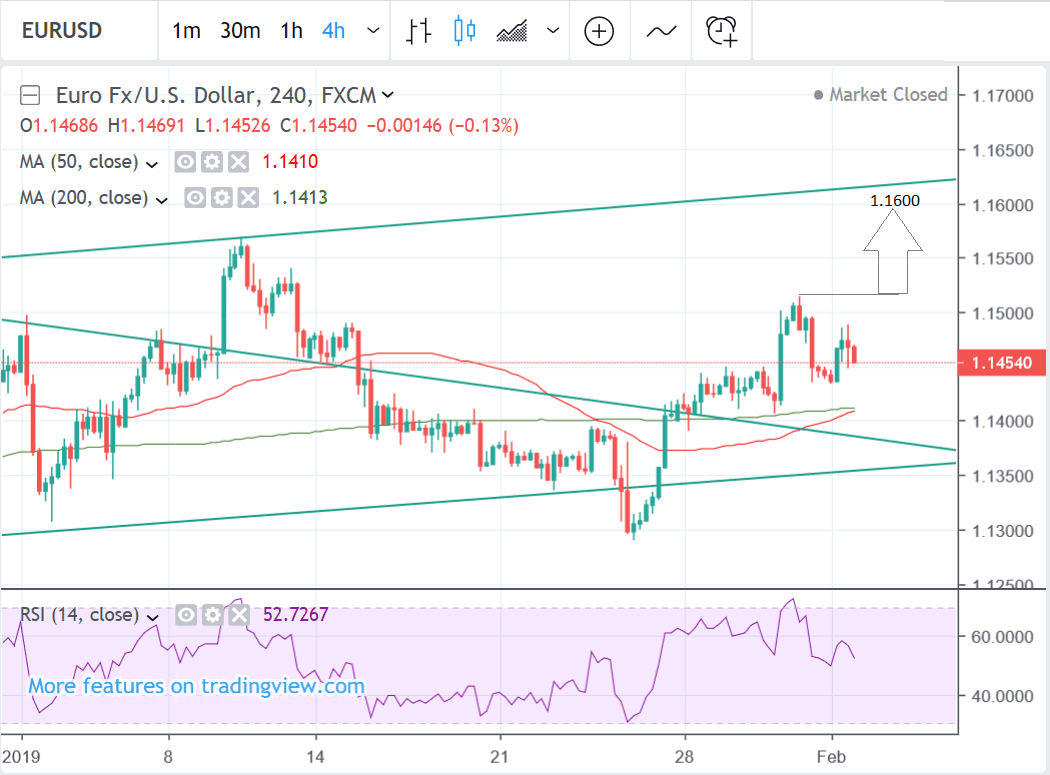Euro-to-Dollar Week Ahead Forecast: Retest Above Long-Term Trendline Provides Bullish Bias

Image © Adobe Images
- Marginally more likely to rise after trendline break
- Break above 1.16 required
- Main release for Euro retail sales; services ISM main release for Dollar
The EUR/USD exchange rate is trading at 1.1454 at the start of the new week after rising almost a half a percent during the week before.
The Euro was boosted by data that showed a surprise increase in Eurozone core inflation which kept alive hopes that the European Central Bank (ECB) will raise interest rates later this year, a move which would increase net foreign capital inflows, driving up demand for the single currency.
The U.S. Dollar, meanwhile, benefited from strong employment data towards the end of the week but political and trade risks continued to exert a dampening effect.
We are very marginally bullish the exchange rate after a key break above a long-term trendline - assuming the break holds in the week ahead.
The pair broke back above the long-term trendline drawn from the January 2018 highs in the week before after breaking but failing to hold the break at the end of December, and this is a bullish sign since the trendline now looks vanquished.
The pair also remains propped up by the 200-week moving average (MA), which has been providing a strong ‘arm’ of support ever since the October lows. Given this healthy support base and the break, we see a very marginal bias to the upside.
The RSI momentum indicator also looks fairly bullish as it is rising in line with the exchange rate and thus reinforcing an uptrending outlook.
Despite these bullish signs the daily chart looks relatively ambiguous with the pair oscillating within a broad sideways trend between range highs at roughly 1.1600 and range lows at around 1.1200.
Ideally, we would want to see a clear break above the range highs at 1.1600 for confirmation of a breakout higher, with an initial target at 1.1700.
Alternatively, a break below the January lows at 1.1289 would probably signal a move down to the range floor at roughly 1.1200.
Judging from the 4hr chart there may even be a case for arguing that a break above the 1.1514 highs could lead to an extension higher, initially to the range ceiling at 1.1600, as this would probably establish a sequence of higher highs and lows on the 4hr time frame, which is the first sign of the start of a new uptrend.
This could very well happen in the week ahead, whilst a full breakout from the range may take longer to evolve, with a horizon of a week to a month.
Time to move your money? Get 3-5% more currency than your bank would offer by using the services of foreign exchange specialists at RationalFX. A specialist broker can deliver you an exchange rate closer to the real market rate, thereby saving you substantial quantities of currency. Find out more here.
* Advertisement
The Euro: What to Watch this Week
Market sentiment with regards to the outlook for Eurozone economic growth has deteriorated to the extent they are no longer expecting an interest rate from the European Central Bank (ECB) in 2019, rather pushing the date of the first rise well into 2020. The Euro has fallen alongside these expectations. Therefore, we believe risks are to the upside in the event of data beating expectations: should markets get the sense the Eurozone has turned a corner we could well see the Euro come back.
While this week's data is second-tier in nature, it is nevertheless likely to be of greater interest than usual owing to the above dynamics.
The main release for the Euro will probably be retail sales on Tuesday at 10.00 GMT. Given current market concerns about waning Eurozone growth the data could be critical in gauging the state of the Eurozone consumer and high-street spending, a major component of GDP.
The consensus estimate is for a slowdown of -1.6% in December from a 0.6% reading previously (in November) and a slower 0.5% rise annually compared to 1.1% previously. Clearly, an even lower than expected result would weigh on the single currency and vice-versa for a higher result.
The middle to end of the week sees the release of German data.
Concerns around growth in the Eurozone's largest economy of late should see markets pay more attention to the results than would typically be the case.
German Factory orders, for example, out at 7.00 GMT on Wednesday, are expected to have bounced back by 0.3% in December after a -1.0% contraction in November. If they fail it could hurt the Euro, if they exceed expectations the Euro could gain a boost.
Likewise with German industrial production on Thursday, which is forecast to rebound 0.6% in December after a -1.9% decline in the previous month.
Finally, German trade data is out on Friday at 7.00 and forecast to show the surplus shrinking to 18.1bn from 19.0bn Euros in December. This could also be closely watched by market participants trying to assess the impact of the slowdown in China on the Eurozone export market.
Recent evidence suggests demand for European cars, for example, has declined amidst the general economic slowdown in China.
The economic outlook for the Eurozone as a whole will also get an official assessment from the ECB on Thursday, at 9.00, when they publish their latest Economic Bulletin which should show a number of downgrades to growth and inflation expectations following the reecnt slowdown seen in Eurozone economic growth.
The U.S. Dollar: What to Watch this Week
The U.S. Dollar kicks off the week on a solid footing after a better-than-forecast ISM Manufacturing release out at the end of last week saw the Dollar turn around and head higher.
Markets set aside the non-farm payroll report, out hours earlier, and chose to focus on the ISM Manufacturing Report as it offers the most up-to-date snapshot of U.S. economic activity, whereas the jobs report was more backward looking.
The sense we get is that the U.S. economy might not be as soft as the recent market narrative suggests, and therefore if markets start pricing in a stronger economy we could expect a stronger Dollar over coming weeks and months.
The next main release will be a major sentiment survey in the services sector, the ISM Non-Manufacturing PMI in January, which is forecast to show a fall to 57 from 58 previously when results are published on Tuesday at 15.00 GMT.
The ISM is thought of as a leading indicator for the economy so it could impact on the Dollar.
However, judging by the ISM Manufacturing report out last week, the risks are skewed to the upside.
Another major release for the U.S. Dollar is Factor Order data for November, out on Monday at 15.00, which is forecast to show a rebound of 0.2% in November following a decline of -2.1% in the month before. Here too a better-than-anticipated result could see upside for the Dollar (but downside for cable).
Time to move your money? Get 3-5% more currency than your bank would offer by using the services of foreign exchange specialists at RationalFX. A specialist broker can deliver you an exchange rate closer to the real market rate, thereby saving you substantial quantities of currency. Find out more here.
* Advertisement








